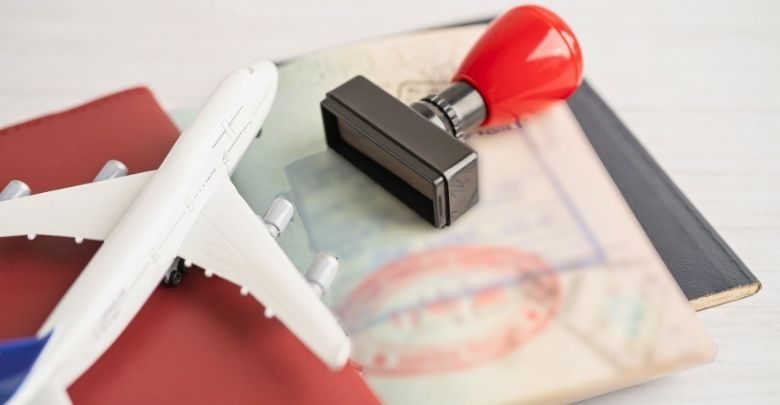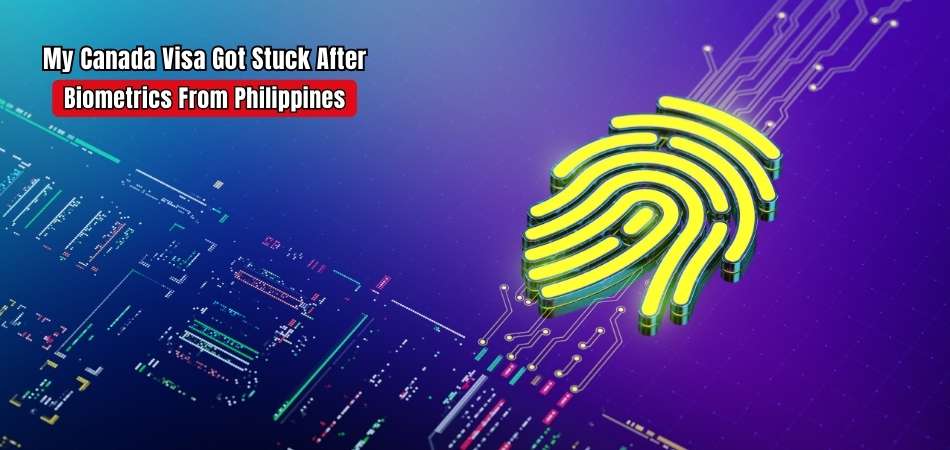Applying for a Canadian visa can sometimes involve lengthy and complex steps. Many applicants, particularly those from the Philippines, experience setbacks after submitting their biometrics. If you find yourself asking, “What to do if my Canada visa got stuck after biometrics from Philippines,” you’re not alone; it’s a common concern.
If you’re facing delays after biometrics, there are a few steps you can take. First, confirm that your biometrics were successfully submitted and linked to your application. Regularly check your application status online, and consider contacting the visa office for updates if you notice extended processing times beyond normal wait periods.
Curious about managing these delays and getting clarity on your visa status? Read on to find complete steps and useful tips to navigate this situation efficiently. This guide covers each step to help you stay proactive and informed during your application process.
Why Do Canadian Visas Get Stuck After Biometrics From the Philippines?
Delays in Canadian visa processing after biometrics submissions are a common concern for applicants from the Philippines. This often occurs due to high application volumes and increased demand, particularly among those seeking study, work, or travel opportunities. Processing backlogs can also stem from limited Canadian visa officers stationed in the region, slowing down response times.
Another significant factor is the security checks each application undergoes. Canada takes meticulous care to screen applicants, ensuring the integrity of its immigration system. This screening process, while necessary, adds time to the processing pipeline, particularly when additional verification is required.
Technical issues with the biometric systems may also cause delays. In some cases, problems with scanning or data transmission can lead to further hold-ups, requiring applicants to re-submit or confirm their information.
To avoid delays, applicants should follow all required steps to complete biometrics for a Canada visa in the Philippines carefully and ensure their information is accurate and complete. Patience is key, as processing times can vary significantly depending on the applicant’s case and external factors affecting the visa process.
My Canada Visa Got Stuck After Biometrics From Philippines: What to Do?
Experiencing delays in your Canada visa process after completing biometrics can feel stressful. Knowing the next steps and knowing what actions to take helps you go through this process smoothly. Below are essential steps to manage your application delay.
Step 1. Verify Submission Confirmation and Processing Timeline
Ensure you have received confirmation that your biometrics were successfully submitted to the Canadian authorities. If you haven’t received an acknowledgment, it may indicate a processing glitch. Always check the official Canada immigration website for updated timelines, as processing times fluctuate often. Staying informed can help you find out if your situation aligns with standard wait times or if it is taking unusually long.
Step 2. Regularly Check Your Application Status Online
Use the Government of Canada’s official website to track your application status and stay informed on any updates. This online tool provides real-time updates and can indicate whether your biometrics were received. Log into your account regularly, as status changes often without email notifications, helping you catch potential delays sooner.
Step 3. Confirm Biometrics Have Been Linked to Your Application
After giving biometrics, ensure they are properly linked to your application by checking online or contacting the immigration service. A mismatch or unlinked biometrics may delay processing significantly. Reviewing your application details and confirming biometrics status can help you identify if this issue may be causing delays.
Step 4. Contact the Canadian Visa Office or VFS Center in Your Region
Reaching out to the Canadian Visa Office or the Visa Facilitation Services (VFS) center handling your application can provide clarity. Ask for assistance in checking if your biometrics data has been received and processed. Ensure you provide your reference number and personal details for an accurate response.
Step 5. Submit a Webform Inquiry for Further Assistance
If your application remains delayed without clear reasons, submitting a webform inquiry on the Canada immigration website can help you gain more information. This form allows applicants to seek official clarification and express concerns. Be clear and concise, as a well-articulated request may lead to quicker assistance from immigration authorities.
Step 6. Seek Help from an Immigration Consultant
Consulting a registered immigration advisor can offer useful insights into handling prolonged delays in visa processing. These professionals are experienced in dealing with application hurdles and can guide you in resolving issues with your biometrics or processing. Look for regulated consultants to ensure reliable guidance in managing your case.
Step 7. Monitor Your Email for Updates and Required Actions
Check your email regularly for any updates from the Canadian immigration office, as they may request further information. Sometimes, additional document requests can hold up the process, so quick responses help avoid further delays. Ensure you have provided an active email and check all folders, including spam, for updates.
Step 8. Remain Patient and Be Prepared for Delays
Visa processing timelines can vary, especially during peak application periods or unforeseen events. Preparing for potential delays can help you manage expectations and reduce frustration. Staying proactive and patient gives you the resilience needed to handle this process calmly, even when things are slow.
Patience and persistence are essential when navigating Canada’s visa process. Following these steps can help you manage unexpected delays. Remember, thorough preparation and informed actions can make a difference in managing your application timeline effectively.
How Long Does Canada Visa Processing Take After Biometrics?
Knowing the processing time for a Canada visa after biometrics can ease your concerns and keep you prepared. Many factors influence the duration, each playing a role in determining the overall wait time. Below you will find out more:
Type of Visa Application
Each visa category has a different processing time, with visitor visas taking 2–8 weeks, work permits 4–8 weeks, study permits 3–7 weeks, and permanent residence 6–8 months. Some categories require more checks, extending wait times, while others are processed more quickly due to simpler requirements.
Country of Application
Processing speed depends on where the application is submitted, as high-demand regions face longer wait times. Visa offices in these areas handle larger volumes, slowing the process. Applying in a low-demand region can lead to faster processing, while busy offices may extend the timeline during peak months.
Seasonal Demand and Application Volume
Visa processing times can increase during peak periods, like summer and holidays, when application numbers surge. High application volumes cause delays as immigration staff manage a larger workload. Planning around these peak times can help avoid seasonal backlogs and may result in faster processing for applicants.
Accuracy and Completeness of Documentation
Inaccurate or incomplete documents can lead to requests for further information, delaying visa processing by weeks. Providing accurate, complete documentation from the start keeps processing times within the estimated timeline. Missing information often causes delays, so checking for errors can save valuable time in the process.
Background Checks and Security Clearances
Some applications require detailed background checks, adding weeks to processing times. Security screenings vary depending on factors like travel history and application type. Certain regions may face additional scrutiny, which extends wait times. These checks are essential but can impact the total time needed for visa processing.
Many factors impact Canada visa processing times after biometrics, and being aware of these can help you anticipate potential delays. Remaining informed and ensuring accuracy in your application can contribute to a smoother, more predictable process while awaiting a decision.
Common Issues in Canada Visa Processing From Philippines and How to Avoid Them?
Canada visa processing from the Philippines involves several steps, and challenges can arise along the way. Knowing the potential obstacles is essential to avoid delays or issues that might impact your application’s success. Here are some tips to help you overcome common obstacles.
Incomplete Documentation and Missing Information
One of the most common issues is submitting incomplete or incorrect documents, which can delay or even result in rejection possibilities after biometrics for Canada visa applications. Checking requirements thoroughly and double-checking all details ensures that your application meets all the standards and minimizes processing delays.
Mistakes in Personal or Contact Details
Errors in personal information or contact details, like misspelled names or wrong email addresses, can slow down processing. Ensuring accuracy in your submitted data helps avoid complications that may arise later, including issues with biometrics results or appointment confirmations. Accuracy also prevents further delays due to clarification requests.
Financial Documentation Issues
When applying for a visa, particularly for a visitor or study permit, financial proof is frequently an essential requirement. Insufficient funds or unclear documentation can lead to rejection. Providing clear, well-documented evidence of financial support reassures immigration officers of your ability to support yourself while in Canada.
Incorrect Visa Category Selection
Applying under the wrong visa category can complicate the process, resulting in unnecessary delays. Choosing the correct category that aligns with your purpose of travel is essential to avoid rejections and processing issues. Knowing the specific requirements for your chosen visa type ensures a smoother, more accurate application process.
Security and Background Check Delays
Some applicants face delays due to extended background or security checks, especially if travel history includes high-risk regions. Preparing for possible delays by ensuring your background information is accurate can help prevent unexpected hold-ups. Such checks are crucial to your visa’s outcome and can impact your processing time significantly.
Canada visa processing can be challenging, but knowing the common issues and ways to avoid them helps streamline the process. Remaining informed and meticulous ensures your application proceeds smoothly, reducing unnecessary delays or risks of rejection.
Tips for Staying Patient During Canada Visa Processing Delays
Waiting for your Canada visa can be a test of patience, especially when delays arise. Staying positive and proactive can make the process smoother. Here are some helpful tips to keep calm and focused below.
- Focus on Personal Goals: Use the waiting period to work on personal goals or skills you’ve wanted to improve, which keeps your mind active.
- Stay Informed But Limit Updates: Checking for updates constantly can increase anxiety. Set specific times to check, like once a week, for peace of mind.
- Engage in New Hobbies: Trying out new hobbies can provide a creative outlet and a great way to redirect your focus from waiting.
- Connect with Others in the Same Process: Joining online forums or groups with others waiting for their visas helps you share experiences, advice, and support.
- Practice Relaxation Techniques: Incorporate daily relaxation practices like deep breathing, meditation, or short exercises to manage stress and increase patience.
- Organize and Prepare for Your Move: Use the time to plan your travel arrangements and make a checklist, which gives you a feeling of productivity.
- Remind Yourself of Your Purpose: By keeping in mind why you are seeking this visa, you stay grounded and focused, which can make the wait more bearable.
Waiting for a visa can be stressful, but using this time constructively helps you stay calm and prepared. By managing your focus and emotions, you’ll ensure a positive experience once your journey to Canada begins.
Frequently Asked Questions (FAQs)
If your Canada visa process has stalled after completing biometrics, you likely have questions about what could be causing this delay. Below are some common FAQs to guide you through potential issues and steps you can take to manage your application status more effectively.
What Happens If My Biometrics Expire Before My Visa Is Approved?
If your biometrics expire during processing, you might need to submit new biometrics. This is especially true if the visa office requests an update. Monitor the expiration date and contact the Canadian Visa Center to confirm whether you need to retake them to avoid additional delays.
Can Missing Documents Cause Delays After Biometrics?
Missing documents can significantly delay your visa application. After biometrics, immigration officers require all necessary documentation to process your visa. If any documents are missing or incorrect, the visa office may contact you for clarification or additional paperwork. Ensure your submission is complete to prevent further delays in the approval process.
How Long Do Background Checks Take After Biometrics?
After biometrics, background checks may take a few weeks, depending on your country of origin and personal history. These checks are crucial for security clearance and can extend the processing time. If there are no issues with your background, it should not take long, but you should be prepared for possible delays.
What Should I Do If My Application Status Hasn’t Updated?
If your application status hasn’t been updated, it’s best to check your online account regularly. Sometimes, updates are delayed due to the volume of applications being processed. If you’ve waited longer than expected, contact the visa office or use the webform inquiry to seek clarification on the status of your application.
Will Resubmitting My Application Speed Up The Process?
Usually, resubmitting your application does not expedite the procedure. It may even delay it further by creating duplicate records or confusion. If your application is stuck, it’s better to wait for the immigration office to process the information. Contact them if you believe there’s an issue with your application.
Bottom Line
Handling a visa delay can be challenging, especially when it happens after completing biometrics. Many applicants face delays due to backlogs, incomplete documents, or extended background checks. Keeping these factors in mind can help you understand what to do if my Canada visa got stuck after biometrics from Philippines.
As you wait, remember to stay proactive by checking your application status regularly and ensuring all documents are accurate and complete. Patience and preparation are key, so stay informed, and best wishes for a smooth visa approval soon!








